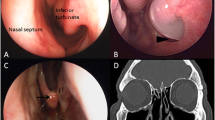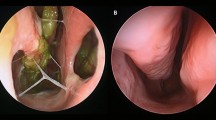Abstract
Empty nose syndrome (ENS) is a rare post-surgical condition characterised by symptoms of nasal obstruction, crusting, pain and suffocation. The pathophysiology remains elusive however a combination of disruption in nasal aerodynamics and neurosensory components is thought to be involved. The rarity of this condition as well as the lack of objective diagnostic criteria make diagnosis difficult. As ENS is a complex condition a multidisciplinary approach to assess the suitability of medical, surgical and psychological treatments may be beneficial.
Access this chapter
Tax calculation will be finalised at checkout
Purchases are for personal use only
Similar content being viewed by others
References
Scheithauer MO. Surgery of the turbinates and "empty nose" syndrome GMS current topics in otorhinolaryngology. Head Neck Surg. 2010;9:Doc03.
Chhabra N, Houser SM. The Diagnosis and Management of Empty Nose Syndrome. Otolaryngol Clin N Am. 2009;42(2):311–30.
Sozansky J, Houser SM. Pathophysiology of empty nose syndrome. Laryngoscope. 2015;125(1):70–4.
Velasquez N, Thamboo A, Habib AR, Huang Z, Nayak JV. The Empty Nose Syndrome 6-Item Questionnaire (ENS6Q): a validated 6-item questionnaire as a diagnostic aid for empty nose syndrome patients. Int Forum Allergy Rhinol. 2017;7(1):64–71.
Le Bon S-D, Horoi M, Le Bon O, Hassid S. Intranasal trigeminal training in empty nose syndrome: a pilot study on 14 patients. Clin Otolaryngol. 2020;45(2):259–63.
Houser SM. Surgical treatment for empty nose syndrome. Arch Otolaryngol Head Neck Surg. 2007;133(9):858.
Li C, Farag AA, Maza G, McGhee S, Ciccone MA, Deshpande B, et al. Investigation of the abnormal nasal aerodynamics and trigeminal functions among empty nose syndrome patients. Int Forum Allergy Rhinol. 2018;8(3):444–52.
Naftali S, Rosenfeld M, Wolf M, Elad D. The air-conditioning capacity of the human nose. Ann Biomed Eng. 2005;33(4):545–53.
Pérez-Mota J, Solorio-Ordaz F, Cervantes-de GJ. Flow and air conditioning simulations of computer turbinectomized nose models. Med Biol Eng Comput. 2018;56(10):1899–910.
Pl D, Marco A, Maria L, Luisa B. Treatment of hypertrophy of the inferior turbinate: long-term results in 382 patients randomly assigned to therapy. Ann Otol Rhinol Laryngol. 1999;108(6):569–75.
Radulesco T, Meister L, Bouchet G, Jrm G, Dessi P, Perrier P, et al. Functional relevance of computational fluid dynamics in the field of nasal obstruction: a literature review. Clin Otolaryngol. 2019;44(5):801–9.
Zhao K, Jiang J, Blacker K, Lyman B, Dalton P, Cowart BJ, et al. Regional peak mucosal cooling predicts the perception of nasal patency. Laryngoscope. 2014;124(3):589–95.
Zhao K, Blacker K, Luo Y, Bryant B, Jiang J. Perceiving nasal patency through mucosal cooling rather than air temperature or nasal resistance. PLoS One. 2011;6(10):e24618.
Baraniuk JN. Subjective nasal fullness and objective congestion. Proc Am Thorac Soc. 2011;8(1):62–9.
Konstantinidis I, Tsakiropoulou E, Chatziavramidis A, Ikonomidis C, Markou K. Intranasal trigeminal function in patients with empty nose syndrome. Laryngoscope. 2017;127(6):1263–7.
Kuan EC, Suh JD, Wang MB. Empty nose syndrome. Curr Allergy Asthma Rep. 2015;15(1):1–5.
Saafan ME. Acellular dermal (alloderm) grafts versus silastic sheets implants for management of empty nose syndrome. European archives of oto-rhino-laryngology: official journal of the European Federation of Oto-Rhino-Laryngological Societies (EUFOS): affiliated with the German Society for Oto-Rhino-Laryngology-Head and Neck. Surgery. 2013;270(2):527–33.
Manji J, Nayak JV, Thamboo A. The functional and psychological burden of empty nose syndrome. Int Forum Allergy Rhinol. 2018;8(6):707–12.
Huang CC, Wu PW, Fu CH, Chang PH, Wu CL, Lee TJ. What drives depression in empty nose syndrome? A Sinonasal Outcome Test-25 subdomain analysis. Rhinology. 2019;57(6):469–76.
Thamboo A, Velasquez N, Habib ARR, Zarabanda D, Paknezhad H, Nayak JV. Defining surgical criteria for empty nose syndrome: Validation of the office-based cotton test and clinical interpretability of the validated Empty Nose Syndrome 6-Item Questionnaire. Laryngoscope. 2017;127(8):1746–52.
Hong HR, Jang YJ. Correlation between remnant inferior turbinate volume and symptom severity of empty nose syndrome. Laryngoscope. 2016;126(6):1290–5.
Leong SC. The clinical efficacy of surgical interventions for empty nose syndrome: A systematic review. Laryngoscope. 2015;125(7):1557–62.
Lee TJ, Fu CH, Wu CL, Tam YY, Huang CC, Chang PH, et al. Evaluation of depression and anxiety in empty nose syndrome after surgical treatment. Laryngoscope. 2016;126(6):1284–9.
Chang FY, Fu CH, Lee TJ. Outcomes of olfaction in patients with empty nose syndrome after submucosal implantation. Am J Otolaryngol. 2021;42(4):102989.
Author information
Authors and Affiliations
Corresponding author
Editor information
Editors and Affiliations
Rights and permissions
Copyright information
© 2023 The Author(s), under exclusive license to Springer Nature Switzerland AG
About this chapter
Cite this chapter
Iqbal, I.Z. (2023). Empty Nose Syndrome. In: Swift, A.C., Carrie, S., de Souza, C. (eds) Contemporary Rhinology: Science and Practice. Springer, Cham. https://doi.org/10.1007/978-3-031-28690-2_47
Download citation
DOI: https://doi.org/10.1007/978-3-031-28690-2_47
Published:
Publisher Name: Springer, Cham
Print ISBN: 978-3-031-28689-6
Online ISBN: 978-3-031-28690-2
eBook Packages: MedicineMedicine (R0)




